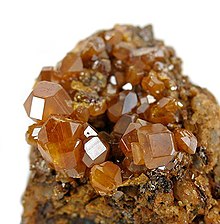
Wolframite is an iron, manganese, and tungstate mineral with a chemical formula of (Fe,Mn)WO4 that is the intermediate mineral between ferberite (Fe2+ rich) and hübnerite (Mn2+ rich). Along with scheelite, the wolframite series are the most important tungsten ore minerals. Wolframite is found in quartz veins and pegmatites associated with granitic intrusives. Associated minerals include cassiterite, scheelite, bismuth, quartz, pyrite, galena, sphalerite, and arsenopyrite.

A scintillator is a material that exhibits scintillation, the property of luminescence, when excited by ionizing radiation. Luminescent materials, when struck by an incoming particle, absorb its energy and scintillate. Sometimes, the excited state is metastable, so the relaxation back down from the excited state to lower states is delayed. The process then corresponds to one of two phenomena: delayed fluorescence or phosphorescence. The correspondence depends on the type of transition and hence the wavelength of the emitted optical photon.
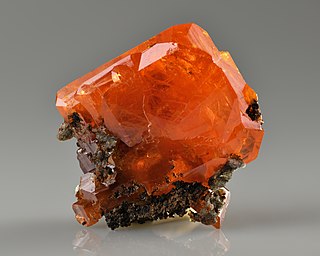
Wulfenite is a lead molybdate mineral with the formula PbMoO4. It can be most often found as thin tabular crystals with a bright orange-red to yellow-orange color, sometimes brown, although the color can be highly variable. In its yellow form it is sometimes called "yellow lead ore".

Acanthite is a form of silver sulfide with the chemical formula Ag2S. It crystallizes in the monoclinic system and is the stable form of silver sulfide below 173 °C (343 °F). Argentite is the stable form above that temperature. As argentite cools below that temperature its cubic form is distorted to the monoclinic form of acanthite. Below 173 °C acanthite forms directly. Acanthite is the only stable form in normal air temperature.
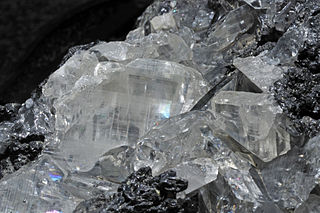
Anglesite is a lead sulfate mineral with the chemical formula PbSO4. It occurs as an oxidation product of primary lead sulfide ore, galena. Anglesite occurs as prismatic orthorhombic crystals and earthy masses, and is isomorphous with barite and celestine. It contains 74% of lead by mass and therefore has a high specific gravity of 6.3. Anglesite's color is white or gray with pale yellow streaks. It may be dark gray if impure.

Scheelite is a calcium tungstate mineral with the chemical formula CaWO4. It is an important ore of tungsten (wolfram). Scheelite is originally named after Swedish chemist Carl Wilhelm Scheele (1742–1786). Well-formed crystals are sought by collectors and are occasionally fashioned into gemstones when suitably free of flaws. Scheelite has been synthesized using the Czochralski process; the material produced may be used to imitate diamond, as a scintillator, or as a solid-state lasing medium. It was also used in radium paint in the same fashion as was zinc sulphide, and Thomas Edison invented a fluoroscope with a calcium tungstate-coated screen, making the images six times brighter than those with barium platinocyanide; the latter chemical allowed Röntgen to discover X-rays in early November 1895.

Hübnerite or hubnerite is a mineral consisting of manganese tungsten oxide (chemical formula MnWO4). It is the manganese endmember of the manganese–iron wolframite solid solution series. It forms reddish brown to black monoclinic prismatic submetallic crystals. The crystals are typically flattened and occur with fine striations. It has a high specific gravity of 7.15 and a Mohs hardness of 4.5. It is transparent to translucent with perfect cleavage. Refractive index values are nα = 2.170 – 2.200, nβ = 2.220, and nγ = 2.300 – 2.320.

Ferberite is the iron endmember of the manganese–iron wolframite solid solution series. The manganese endmember is hübnerite. Ferberite is a black monoclinic mineral composed of iron(II) tungstate, FeWO4.
Cadmium tungstate (CdWO4 or CWO), the cadmium salt of tungstic acid, is a dense, chemically inert solid which is used as a scintillation crystal to detect gamma rays. It has density of 7.9 g/cm3 and melting point of 1325 °C. It is toxic if inhaled or swallowed. Its crystals are transparent, colorless, with slight yellow tint. It is odorless. Its CAS number is 7790-85-4. It is not hygroscopic.
The Molière radius is a characteristic constant of a material giving the scale of the transverse dimension of the fully contained electromagnetic showers initiated by an incident high energy electron or photon. By definition, it is the radius of a cylinder containing on average 90% of the shower's energy deposition. Two Molière radii contain 95% of the shower's energy deposition. It is related to the radiation length X0 by the approximate relation RM = 0.0265 X0 (Z + 1.2), where Z is the atomic number. The Molière radius is useful in experimental particle physics in the design of calorimeters: a smaller Molière radius means better shower position resolution, and better shower separation due to a smaller degree of shower overlaps.
Mosesite is a very rare mineral found in few locations. It is a mercury mineral found as an accessory in deposits of mercury, often in conjunction with limestone. It is known to be found in the U.S. states of Texas and Nevada, and the Mexican states of Guerrero and Querétaro. It was named after Professor Alfred J. Moses (1859–1920) for his contributions to the field of mineralogy in discovering several minerals found alongside mosesite. The mineral itself is various shades of yellow and a high occurrence of spinel twinning. It becomes isotropic when heated to 186 °C (367 °F).
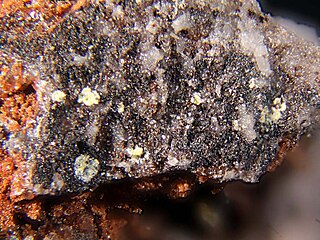
Russellite is a bismuth tungstate mineral with the chemical formula Bi2WO6. It crystallizes in the orthorhombic crystal system. Russellite is yellow or yellow-green in color, with a Mohs hardness of 3+1⁄2.

Raspite is a mineral, a lead tungstate; with the formula PbWO4. It forms yellow to yellowish brown monoclinic crystals. It is the low temperature monoclinic dimorph of the tetragonal stolzite.
Pinalite is a rare lead tungstate–chloride mineral with formula: Pb3WO5Cl2.
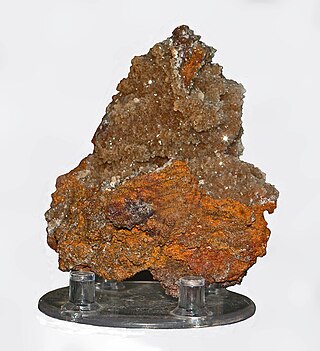
Tarbuttite is a rare phosphate mineral with formula Zn2(PO4)(OH). It was discovered in 1907 in what is now Zambia and named for Percy Coventry Tarbutt.

The Research Institute for Nuclear Problems of Belarusian State University is a research institute in Minsk, Belarus. Its main fields of research are nuclear physics, particle physics, materials science and nanotechnology.
Metarauchite is a member of the autunite group, found at the Jáchymov ore district, Czech Republic and in Schneeberg, Germany. The autunite group is a group of structured uranyl phosphates and arsenates; the other members of the group are autunite, bassetite, heinrichite, kahlerite, nováčekite-I, nováčekite-II, rauchite, sabugalite, saléeite, torbernite, uranocircite, uranospinite, and zeunerite. The mineral is named after Czech mineral collector Luděk Rauch, who died in the Jáchymov mines during mineral prospecting.
Lahnsteinite is a basic sulfate mineral first discovered in the Friedrichssegen Mine, Germany in a goethite cavity. Though found in goethite, the crystals of Lahnsteinite are few millimeters in size, and are tabular shaped. Lahnsteinite was the first mineral discovered in the Lahn Valley deposits. The empirical formula for lahnsteinite is (Zn3.3,Fe0.27,Cu0.11)3.91(S0.98O4)(OH)5*3H2.10O.
Parascorodite is a rare, secondary iron-arsenate mineral. It has a chemical formula of (FeAsO4·2H2O) and was discovered in 1967 using X-ray powder diffraction methods, when an unknown substance was found along with scorodite on medieval ore dumps in the Czech Republic. The holotype of parascorodite can be found in the mineralogical collection of the National Museum, Prague, Czech Republic under acquisition number P1p25/98.
Ophirite is a tungstate mineral first discovered in the Ophir Hill Consolidated mine at Ophir district, Oquirrh Mountains, Tooele County, Utah, United States of America. It was found underground near a calcite cave in one veinlet, six centimeters wide by one meter long, surrounded by different sulfides. Before the closing of the mine in 1972, it was dominated by sulfide minerals, and the Ophir district was known for being a source of zinc, copper, silver, and lead ores. The crystals are formed as tablets. It is the first known mineral to contain a heteropolyanion, a lacunary defect derivative of the Keggin anion. The chemical formula of ophirite is Ca2Mg4[Zn2Mn3+2(H2O)2(Fe3+W9O34)2] · 46•H2O. The mineral has been approved by the Commission on New Minerals and Mineral Names, IMA, to be named ophirite for its type locality, the Ophir Consolidated mine.
